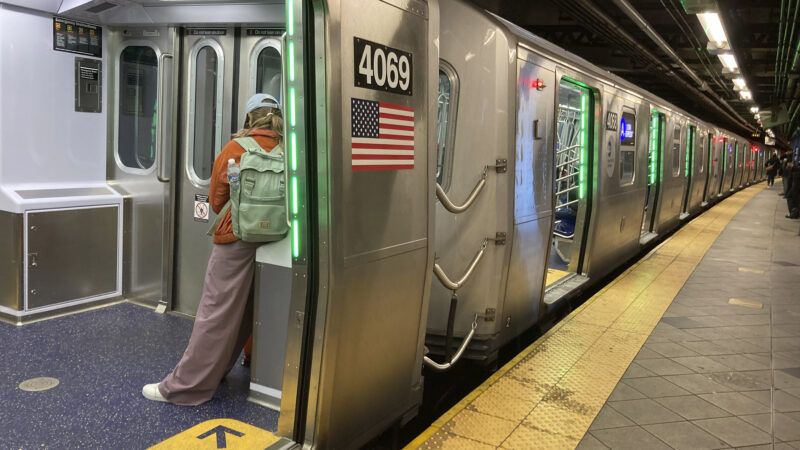Problems With Mass Transit Won't Be Solved With More Money
The transit systems we're supposed to hop aboard ultimately operate as jobs programs for government workers.

California's public-transit systems are facing a crisis, as already-declining ridership levels fell another 80 percent in the midst of COVID-19. They have only rebounded to 60 percent after the end of the shutdown. Most agencies are facing fiscal calamity and, predictably, state lawmakers are seeking to infuse them with additional cash now that federal pandemic-related subsidies are subsiding.
With the state government now staring down a $25-billion deficit, there's no extra general-fund cash to prop up struggling systems. That may be a silver lining. Transit's problems have little to do with inadequate subsidies, so perhaps this challenge will force policymakers to rethink the fundamental problem: Our transit systems are so unpleasant that people don't want to use them.
State planners have been dumping record amounts of money into transit for years in the hopes that Californians will abandon their cars, but to no avail. The Southern California Association of Governments found that the region's "median" resident made zero transit trips in a year—and that transit ridership is concentrated in a fraction of the area's census tracts.
"Without the state stepping in," transit agencies "say they may have to cut service or increase fares," according to a CalMatters report. That's the definition of a death spiral. Because of less revenue, the agencies will reduce and charge more for their already shoddy service. As a result, fewer people will use the service and that will lead to more cutbacks and higher fares. Transit's problems predate the pandemic, by the way. Per-capita transit use plateaued in 1970.
If you peruse California's transportation documents, you'll find little focus on the nuts-and-bolts of transportation. Instead of improving the roads that most of us rely upon and building quality transit for those who depend upon it, the state is devoted to a policy of planned congestion that seeks to make us so miserable we abandon the cars that we rely upon. Just check out the trendy "road diets" that eliminate vital traffic lanes in favor of bike lanes.
The transit systems we're supposed to hop aboard ultimately operate as jobs programs for government workers and schemes that battle climate change. On the former point, the Bay Area Rapid Transit (BART) system has a janitor who earned $270,000 in total compensation in a year. They view the rider—or potential rider—as an afterthought. That undermines their own stated goals.
"Getting more people out of their own gas-powered cars is essential to meeting the state Air Resources Board's goal to reduce greenhouse gas emissions 48 percent below 1990 levels by 2030," the CalMatters article added. The state has been underinvesting in freeways given that it perceives transit as the future—and lawmakers are busy trying to re-order development patterns so that more of us live in high-density, transit-dependent neighborhoods.
But no one stops to ask, "How are we going to entice (rather than force) Californians onto these mass-transit systems? And they plow ahead with a $100-billion "high speed" train that might one day take a handful of residents from Merced to Bakersfield.
Meanwhile, those people who take transit complain about constant delays, long travel times, uncomfortable and dirty buses—and crime. BART is enduring a crime wave. An L.A. Metro survey last year found that ridership among women has fallen off a cliff—with the key cited reason being crime and a lack of cleanliness. After that system experimented with free ridership during the pandemic, vagrants overran their buses and trains. Go figure.
Such mundane consumer-oriented concerns explain why people increasingly avoid transit, yet the California Department of Transportation's main planning document is preoccupied with promoting "vibrant communities," advancing "racial and economic justice" and bolstering "public and environmental health." Those goals are fine, but the agencies can't even manage systems that commuters feel safe to use.
Transit agencies face a conundrum. Because they view transit ridership largely in equity terms, they design the systems largely as social-welfare programs designed to provide poorer residents with a means to get around. Yet when they dump billions of dollars in boutique rail lines, they inevitably cannibalize funds from the bus routes that serve the bulk of their riders—and few drivers end up taking those rail lines, anyway.
The state's progressive leaders seem to disdain cars, so they prefer hectoring drivers about their climate footprint and punishing them for driving pickup trucks. They forget that the bulk of lower-income people also rely on their cars—and that car ownership remains a key stepping stool into the middle class.
Instead of thinking like business-people who need to meet the needs of customers, California transit officials act like government bureaucrats who are married to high-cost government and union solutions, and mainly want to impose their preferences on us—rather than lure us into transit by offering high-quality transportation alternatives. Until they change their thinking, Californians will continue to vote with their gas pedals.
This column was first published in The Orange County Register.
